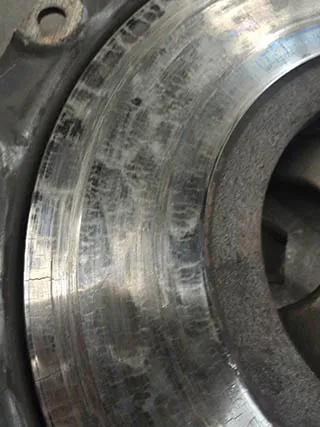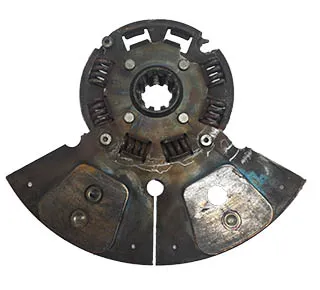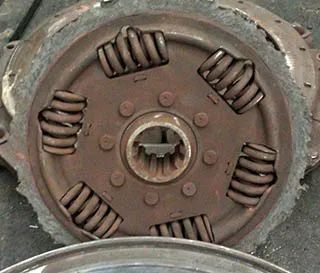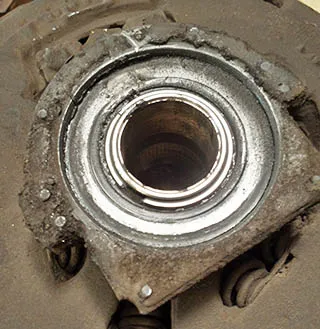Excessive Heat
Pressure Plate Heat Damage
Excessive heat is the leading cause of clutch failure. When the temperature between the flywheel, discs, intermediate plate (floater plate), and pressure plate exceeds operating specifications, the friction material may wear away, and the metal components of the clutch can distort. This can lead to catastrophic clutch failure, posing significant risks to life, limb, and property.

Operator Errors
While excessive heat is the leading cause of clutch failure, improper vehicle operation is the primary driver of excessive heat. Actions that cause clutch slippage generate heat faster than it can dissipate, leading to premature wear and failure. Below are common operational errors that can initiate clutch failure:
- Riding the Clutch Pedal While in Motion:
This mimics the effects of a slipping clutch, applying continuous pressure on the release bearing and often causing it to fail. - Holding a Vehicle Stationary on an Incline with a Slipping Clutch:
Prolonged clutch slippage generates excessive heat and damages components. - Exceeding Load Specifications:
Overloading a vehicle can strain the clutch beyond its capacity, causing overheating and failure. - Starting in the Wrong Gear:
Initial movement in an incorrect gear creates unnecessary stress on the clutch. - Insufficient Acceleration Before Upshifting:
Failing to properly accelerate before shifting causes the engine speed and vehicle speed to differ significantly, leading to clutch overheating as it works to equalize speeds. - Skipping Gears While Upshifting:
Skipping gears increases the load on the clutch, exacerbating overheating and wear.
14" Pot Style Clutch
- Grooved Drive Pin Slots:
Incorrectly angled drive pins
Reuse of old drive pins
Failure to replace set screws - Worn or Fractured Drive Pins/Drive Slots:
Improper or non-installation of anti-rattle springs
Improper application
Improper maintenance (e.g., filing drive slots to fit angled drive pins) - Insufficient Clutch Release:
Incorrectly angled drive pins
Damaged drive pins
Improper or non-installation of anti-rattle springs
Damaged drive slots
Self-Adjusting Clutch
- Over-Adjusted Self-Adjusting Clutch:
Incorrect distance between the clutch brake and release bearing
Damaged self-adjusting cam tab
Improper maintenance - Excessive Bushing Wear/Failure:
Insufficient lubrication
Improper lubrication type
Bushing contamination
Damage to the transmission input shaft - Non-Adjusting Self-Adjusting Clutch:
Contaminants within the clutch housing - Worn Release Bearing Wear Pad:
Operating the vehicle without proper free play - Excessive Free Play:
Increased free play during the break-in period
Clutch brake not installed
Over-adjusted self-adjusting clutch
Improperly set linkage system
Common Operator Complaints
- Insufficient Clutch Release
Oil-contaminated disc
Incorrectly facing discs
Wrong disc installed
Warped disc
Clutch cover contamination
Missing or improperly tightened clutch cover mounting bolts
Release yoke bridge to cover contact upon full clutch release
Flywheel interference with the disc
Improper clutch cover-to-flywheel fit (Cover pinch)
Partial pressure plate retraction
Lever-to-pressure plate contact
Damaged pressure plate
Intermediate plate catching on improperly angled drive pins
Damaged intermediate plate
Absent clutch brake squeeze
Damaged clutch brake
Improper clutch brake use
Worn transmission drive gear spline
Transmission input drive gear contamination
Incorrect throw-out bearing installed
Throw-out bearing catching on the transmission stem
Damaged or incorrectly fitting pilot bearing
Bushing damage inside the release bearing sleeve
Release sleeve bushing-to-input shaft contact
Improper or non-installation of anti-rattle springs
Damaged or non-set positive separator pin
Improper clutch pedal height
Excessive free pedal
(15” flywheel) Step is greater than 0.002”
(Self-adjusting and SAS only) Incorrectly facing intermediate plate and spacer ring - Clutch Noise
Flywheel interference with the disc
Excessive flywheel run-out
Flywheel interference from the dampener spring cover
Clutch not firmly attached to the flywheel
Failing or improperly installed linkage system
Improper clutch adjustment via the linkage
Yoke bridge-to-cover contact
Release yoke fingers-to-cover contact
Input shaft not moving freely through the disc hubs (due to contamination or corrosion)
Excessive engine idle RPM
Uncovered transmission inspection hole
Damaged pilot bearing or release bearing
Insufficient release bearing lubrication
Worn release sleeve bushing
Damaged throw-out bearing
Retainer interference from the rear disc rivets
Wrong disc installed
Worn or fractured drive pins/drive slots
Incorrect ring rotation
Missing anti-rattle springs - Clutch Chatter
Disc grease or oil contamination
Excessive disc wear
Input shaft spline wear
Bound or worn linkage system
Excessive release yoke finger wear
Worn release bearing wear pads
Improperly set clutch engagement torque (for electronic engines) - Slipping Clutch
Operator errors leading to excessive heat
Lack of free pedal
Prolonged operation without free-play
Improper application
Vehicle overload
Disc grease or oil contamination
Improper clutch adjustment via the linkage
Damaged retainer assembly - Clutch Vibration
Improperly tightened clutch cover mounting bolts
Retainer assembly interference from the rear disc rivets
Improperly set free travel
Linkage system wear
Cross shaft wear
Disc worn down to the rivets
Free play changes due to excessive crankshaft end play
Loose or unbalanced flywheel
Improper seating of the clutch against the flywheel
Excessive flywheel run-out
Clutch Cover/Flywheel/Intermediate Plate/Pressure Plate
Clutch Cover to Yoke Fingers Contact
- Incorrect rotation of the ring
- Fractured release bearing housing
- Yoke finger breakage or excessive wear
- Clutch cover damage
- Incorrect clutch adjustment
- Improperly installed linkage system
- Linkage system breakage
Yoke Bridge to Cover Contact
- Over stroking the yoke to achieve correct clutch brake squeeze, which can result from:
Damaged or incorrect transmission bearing retainer capWorn yoke fingers and/or release bearing padsFractured or missing clutch brake - Incorrect yoke installation
- Improper linkage system setup
- Worn clutch brake
Fractured Clutch Cover
- Straightened release yoke fingers
- Incorrect torque applied to the flywheel mounting bolts
Release Lever to Pressure Plate Contact
- Incorrect release bearing travel
- Worn cross shaft bushings
- Worn cross shafts
Worn Release Lever
- Damaged throw-out bearing
- Improperly fitted throw-out bearing
- Worn or bound linkage

Clutch Cover/Flywheel Detachment
- Incorrect torque applied to the flywheel mounting bolts
Disc Related
Disc Grease/Oil Contamination
- Transmission leakage
- Rear main engine seal leakage
- Failure to remove rust preventative from the flywheel
- Greasing the input shaft splines
- Greasing the disc hub splines
Abnormal Disc Wear
- Unevenly worn or unsurfaced flywheel
Warped Disc
- Improper transmission installation
Flywheel Interfering With the Disc
- Disc rivets contacting the flywheel mounting bolts
- Disc installed in the incorrect direction
- Damaged pilot bearing
- Incorrect clutch installed
Burnt Disc
- Slippage
- Riding the clutch pedal
- Holding a vehicle stationary on an incline with a slipping clutch
- Prolonged operation without free play
- Incorrect clutch installed
- Excessive disc facing wear
- Partial clutch unloading caused by another component failure
- Retainer assembly interference
Damaged Damper Cover
- Forcing the transmission shaft into the disc hub
- Improper transmission installation
Damaged Disc Hub
- Torsional vibrations
- Shock load
- Improper transmission installation
- Incorrect disc installed
- Excessive flywheel run-out

Absent or Damaged Dampener Springs
- Shock load
- Torsional vibrations
- Improper application
- Excessive engine idle RPM

Damaged Disc
- Coasting with the clutch pedal depressed while the vehicle is in gear

Loss of Disc Friction Material
- Coasting with the clutch pedal depressed while the vehicle is in gear at high RPMs

Miscellaneous
Damaged Sleeve Bushing
- Input shaft not centered with the release bearing assembly sleeve during transmission installation
- Unsupported transmission in the sleeve bushing
Release Shaft Wear
- Damaged linkage system
- Variance in free play
- Improper clutch engagement
- Excessive side loading on the release bearing
Damaged Input Shaft Spline
- Torsional vibrations
- Misaligned input shaft
Damaged Input Shaft
- Undue release sleeve pressure on the input shaft
- Damaged linkage system
- Worn release bearing
- Worn release yoke fingers
- Push-starting the truck
- High-speed downshift
Release Sleeve Bushing to Transmission Input Shaft Contact
- Protruding cross shafts through the release yoke
- Damaged release yoke fingers
- Improper clutch cover installation
- Improper fit of the clutch cover into the flywheel pilot
- Misaligned transmission bell housing with the engine housing
- Loose transmission mounting bolts
- Improper linkage system adjustment
Worn Release Yoke Fingers
- Riding the clutch pedal while in motion
- Operating the vehicle without free play
Damaged Retainer Assembly
- Improper transmission installation
- Rivet contact from a worn disc
- Improper clutch adjustment via the linkage
Damaged Positive Separator Pin
- Improper installation
Damaged Kwik-Adjust® System
- Failure to fully depress the adjuster while rotating the gear
- Rotating the gear while the clutch is engaged
Damaged Throw-Out Bearing
- Prolonged partial clutch release while in motion
- Prolonged operation without free play
- Continuous contact with the release levers
Damaged Pilot Bearing
- Insufficient lubrication
- Improper outer bearing race fit in the flywheel
- Improper inner bearing race fit on the input shaft
Release Bearing Failure
- Inadequate lubrication
- Incorrect lubricant
- Prolonged partial clutch release while in motion
- Excessive wear on wear pads and yoke fingers
Excessive Clutch Brake Wear
- Insufficient clutch release
- Engaging the clutch brake while the vehicle is moving and the transmission is in gear
- Improper installation
- Damaged transmission bearing cap
- Clutch brake exceeding its normal life expectancy
